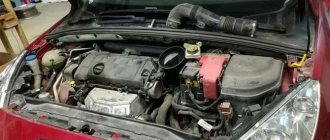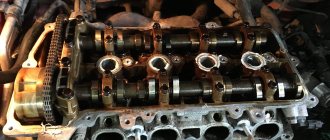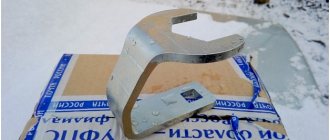Almost every car enthusiast wants his iron horse to serve faithfully. Proper care and timely repairs, oil changes can extend the life of the iron horse. Changing the oil in the variator (CVT) plays an important role in extending the life of the car.
In English, CVT (Continuously Variable Transmission) means constantly changing transmission. This is an excellent alternative to a gearbox. Cars equipped with a CVT accelerate faster. This transmission is continuously variable and has no fixed gear shift points. It is more convenient and economical.
The CVT box in a car performs the following functions:
- removes heat;
- maintains normal, optimal temperature of the box;
- Lubricates differential and pulleys.
Optimized load on the car engine and other drive elements make the CVT more attractive to car enthusiasts. However, one of the problems of owners of cars with a CVT transmission is that not every car service or repair shop undertakes to repair a failed part.
The disadvantages also include that the variator fluid cannot be replaced with any other oils. The fluid is replaced with the one that is suitable for a specific car model. Consequently, a fairly common question among car owners is what kind of oil should be poured into their car to make it last longer.
Manufacturers of CVT lubricants make fluids in the same way as motor oils. Mixtures and lubricants for the variator have viscosity and extreme pressure characteristics. This oil prevents wear and tear on gearbox components. It also ensures uninterrupted operation, which is achieved by reducing friction between moving, movable components and parts of the unit. The lubricating mixture tends to age, become cloudy, become clogged and requires timely replacement.
How and when to change the oil in a variator: photos and videos
Why change the oil in the variator?
It is no secret that the operating principle of a variator differs from conventional automatic transmissions and they use special oil. As a rule, it is marked CVT, that is, literally translated from English as “continuously variable transmission”
It is important to note that this lubricant differs from the usual one in a number of properties.
For example, at a certain temperature, its thin films begin to perform frictional actions. This, in turn, prevents the belt from slipping on the variator cones. That is why it is not easy to add oil here, but also change it on time.
Although the manual for many latest models contains a note that changing the lubricant in the variator is not required, experts still recommend checking its quality from time to time. For example, if the liquid has changed its usual color, smell, or transparency, it is worth changing it. Especially if particulate matter is detected. This can lead to bad consequences.
How to check the oil level?
You can check the level of lubrication using certain signs of the car's operation. For example, if there is little fluid, then the following “symptoms” may occur:
- the car accelerates poorly or does not move at all;
- at the beginning of movement the car jerks;
- The engine vibrates a lot at idle.
- difficulties when changing gears;
- The car moves with the variator switch in position N.
- Place the car on a flat surface.
- Turn on the engine and after it has completely warmed up, turn off the ignition.
- After this, within 60-90 seconds until the oil has cooled down and decreased in volume, you need to take a measurement.
- To do this, you need to remove the fluid level dipstick in the variator (usually the yellow ring), wipe it with a clean dry cloth and insert it back.
- Take the dipstick out again and look at the mark. Depending on this, you will need to either drain the excess or add the missing oil.
When should you change your oil?
As experts advise, it is better not to skimp on replacing the fluid and carry out this procedure every 20,000 kilometers. According to some official data, oil manufacturers advise changing them after 45,000 kilometers, which is approximately every three years. Whether you need to replace it after this period of time or even earlier, of course, depends on different situations. But it’s still better to play it safe by looking at the car’s mileage.
How to replace?
Before moving on to the lubricant replacement procedure, remember that it requires your special care. Make sure that various contaminants do not get on the dipstick or in the guide tube. Even the smallest speck of dust can play the role of sandpaper in a variator.
So, we offer step-by-step instructions on how to change the oil using a Honda Fit as an example.
- Place the vehicle on a repair ramp or use a lift if possible.
- Start the engine and wait until the cooling fan turns on, then turn off the engine.
- Now remove the mudguard, unscrew the drain plug, substitute a convenient container and drain all the oil from the variator.
- Wait until all the liquid has drained from the device. As a rule, this is about 3 liters. At this time, prepare a funnel with which we will replace the lubricant.
- We will fill the oil through the hole where the dipstick is located, but since it is located in a hard-to-reach place, we will need a funnel.
- Close the drain plug using a new sealing washer.
- We fill the variator with new transmission lubricant.
- We check its quantity using the method already known to us (after warming up), that is, using the hot method. Make sure that the oil level in the variator is at the upper HOT indicator.
- That's it. Everything is ready. Good luck!
In this video you will learn about the history of the creation of the variator, its advantages, operating principles and hear other interesting facts.
Have you changed the fluid? Perhaps you have your own way? Share it with us in your reviews!
avtozam.com
Hold the clutch and remove the rear drive shaft nut
After making sure that there are no other components blocking the removal of the variator cover, remove the locking screws in a diagonally opposite sequence, working from the outside to the inside. Pay attention to the position of the individual screws if they are different lengths (write this down!). And make sure you don't lose any of the washers.
You should now be able to remove the cover; if not, check where the sticking point is. You may have forgotten a screw. Whatever you do, don't use force. Only when you are absolutely sure that you haven't missed any screws should you use a rubber mallet to loosen the very tight CVT cover.
If the rear drive shaft protrudes into the cover, you will find that there is a loose bushing somewhere that you should not lose either. Thoroughly clean the inside of the cover from dust and dirt. If there is oil in the CVT housing, you have a leaking motor or drive seal that needs to be replaced immediately. So you have your CVT in all its glory. Lock the variator and disconnect the central nut. Remove the metal ring for easier access.
To install a new drive belt or new CVT pulleys, begin to unfasten the front V-pulley retaining nut on the crankshaft journal. To do this, you need to block the variator using a special tool to prevent it from moving. If the front V-pulley is toothed, you can usually buy a locking tool that fits your vehicle. If there are holes or solid ribs on the surface of the pulley, you can grab it with a suitable holder.
Skilled DIY mechanics can make their own lock or holder from flat steel. If you block the pulley while holding the cooling fins, be very careful to avoid damaging or breaking the fins. If it is not possible to lock the variator, the nut must be removed using a pneumatic wrench (vehicle workshop).
Partial replacement
A partial oil change involves draining the old mixture and filling in a new one. The procedure is repeated until the poured liquid acquires a normal color.
In order to make a partial oil change in the variator, you must follow a certain procedure.
Tools:
- wrenches 10 and 19;
- new fluid for filling into the variator (12 l);
- tray cleaner;
- watering can;
- empty container with a volume of 10 liters.
Step-by-step instruction:
- Warm up the car engine to 90 degrees, and then turn off the engine;
- Unscrew the drain valve under the machine;
- Drain as much liquid as possible;
- Screw the airlock tightly and start the engine;
- Change gears (each several times);
- Stop the engine and drain the fluid;
- Repeat the procedure until the drain takes on the color of the new liquid.
Replacement Items Required
In order to change the oil in the variator efficiently and without any complaints, you must either seek help from professionals, or do it at home, but at the same time acquire a number of special devices:
- Transmission fluid;
- Two oil filters;
- A place where you could look under the bottom of the car. It could be an overpass, a pit, a lift;
- Special set of tools;
The list of special tools may include:
- Key for 10
- Funnel for safely and accurately pouring oil into the variator
- A spray cleaner that will clean the box itself of unnecessary debris.
- Rags that will keep the worker and the box itself clean
- A special flushing liquid is necessary to clean some removable parts from impurities, oils and chips.
- A container into which all the contents of the box could be poured
Possible difficulties and nuances
The most important thing to remember when replacing is that it is better to buy CVT oil at specialized retail outlets or from authorized dealers. It is not recommended to purchase cheap products through third parties - there is a high probability of receiving a low-quality product, which will lead to accelerated wear of the variator
Partial replacement should be carried out every 500-1,000 kilometers, depending on the car model. It is possible and more often, as an alternative to a complete change of the variator oil, to carry it out every 300-500 kilometers, but this option is not considered profitable and rational.
It is impossible not to mention the main difficulty with CVTs. This is a search for new oil and replacement parts. The CVT is a new “phenomenon” and not all specialized stores have the appropriate products for its repair and prevention, unlike an automatic or manual transmission.
Dual Clutch Transmission Oils (DCTF)
Dual clutch transmission fluids are a compromise between high MTF and efficient ATF performance. In addition, the use of hydraulic pumps increases the requirement for stability.
Types of CVTs
In addition to the CVTs described, below is a brief description of the main types used in passenger cars:
Belt-type CVT: Also called "push-type" or "Van Doorne" CVT.
The essence of the system
The belt is clamped into the pulleys under pressure of up to 4 tons and is “pushed” through its pulleys. Compressive loads on individual belt plates vary depending on engine size, but they are quite high, starting at 120 Pascals for a small four-cylinder engine.
Chain-type CVT: Also called "pull-type". This CVT also uses pinch pulleys.
The two main advantages of the design over a belt-driven CVT are: Toroidal CVT: It is quite complex. Imagine putting a cone on a pottery wheel and shaping the sides until they are rounded. Now place the two tori facing each other with the disc-shaped roller between them, touching both. You have a toroidal variator.
Because it does not rely on belts or chains or pinch pulleys, a toroidal CVT can transmit more torque. You won't find a toroidal CVT in Russia - at least not now. It is only found on certain Nissan vehicles sold in Japan.
Although CVTs are cool and useful, there are many reasons why they are not yet installed in every car:
- CVTs are much more complex and expensive to manufacture than they look in pictures on the Internet. Generating high clamping forces that make them work is a challenge for hydraulic systems and lubricants. Parts must meet exact specifications during manufacture and assembly. Various licensing fees also increase costs for the automaker.
- Durability (or rather the lack thereof) has essentially become a big stumbling block. Belt slippage is the Achilles heel of the CVT. If the belt slips even on a tiny pulley, the transmission is further destroyed.
- Some drivers just don't like them. Most people have no idea what kind of transmission they have, but they usually expect the engine to make certain noises when running and nothing else. A car with a CVT sounds almost like a motorboat. When you ride it down a hill, the engine accelerates to high speed and starts humming until you stop. And this system doesn't have a shifter, so there won't be any change in engine tone that you're used to with conventional transmissions. For this reason, owners of cars with CVTs often return them thinking that the transmission is slipping or something is broken.
- Fuel economy gains are currently in line with conventional powertrain gains.
Some automakers believe they can get more fuel-efficient systems with a six- or seven-speed CVT.
Myth one – where is it located?
Often many people don’t even know where this miracle device is located! No, I’m not talking about all the cars at once (maybe someone else installed it), and I’m also not talking about Chinese miracle devices that can be bought on ALI and connected to the ECU or OBD2 connector. I'm talking about the mass segment now.
Read more: Electric motor with high torque
That is, in simple words, it is not physically there and you will not find it installed in any part of the box. Information is accumulated inside the electronic control unit and recorded based on many parameters - such as real operating time, shaft rotation, temperature, mileage, speed, etc. A special algorithm works that assigns points, by counting which you can draw a certain conclusion about the operation of this transmission.
Misconception: The variator is filled with oil for its entire service life.
One sentence contains two inaccuracies. Firstly, the liquid poured into the variator should not be called oil. Just as a classic automatic transmission uses ATF fluid, CVTs use a fluid with its own set of characteristics. Yes, lubricant is present in this list, but this is not the main purpose of such a liquid. For example, working fluid for a variator under pressure increases the coefficient of friction at the point of contact of the cone with the variator belt. Is regular oil capable of this? Of course not.
In classic automatic machines, non-metallic friction linings wear out more. And the variator has steel cones and a belt. Steel dust interferes with the operation of the valves; it can leave the system without fluid pressure, which is necessary for the operation of all automatic transmissions. Therefore, replacing the fluid every 60,000 km is necessary. At the same time, the catching magnets are cleaned of wear products and the filter is changed.
This is interesting: When to turn the steering wheel when turning
How to change CVT oil
So, having dealt with the need for regular maintenance, let's look below at how to change the oil in a variator box. It is not difficult to guess that in this case you can go in two ways:
- change the oil in the variator at a service station;
- change the oil in the CVT yourself;
As for replacement methods, in certain cases they perform: partial (incomplete) replacement of the oil in the box, complete replacement (hardware), complete replacement using the spill method.
Partial fluid replacement in the variator involves updating (refreshing) the oil. To put it simply, part of the lubricant is drained, after which you need to fill in exactly the same amount as was drained before, then adjust the oil level in the variator.
Then the exact same liquid (manufacturer, properties, tolerances) is poured into the box as the one that was poured earlier. This approach will avoid the risks of mixing transmission oils and possible consequences.
It is important to understand that using this method it is possible to renew the fluid in the variator by only a third or a little more of the total volume of fluid. In fact, fresh fluid is mixed with old fluid, which is not drained from the unit through the plug
To achieve a complete replacement, this procedure must be repeated at least 3-4 times (with an interval of 500-700 km). It is also recommended to replace all automatic transmission filters twice (after the first approach and after the last), and wash the pan.
A complete oil change in the variator is carried out using a special installation. The entire replacement involves the displacement method, when the new fluid actually squeezes the old one out of the gearbox (replacement).
Also, hardware replacement allows you to perform the procedure for flushing the variator before pumping oil into the box. Both regular oil and special flushing compounds can be used. Then the oil in the variator on the device is completely changed.
Changing the oil in the variator yourself
To change the oil in a CVT without using special equipment, you will need to prepare:
- fresh oil in the required volume (you need to find out in advance from the manual what kind of lubricant to pour and how many liters to pour into the variator box on a particular car model).
- rags, clean rags, as well as containers for draining, a set of tools;
- pan gasket and/or sealant, CVT oil filter.
- Before replacing the box, you need to warm it up well (drive the car for about 10 km), then put the car on a flat surface in a garage with an inspection hole or lift it on a lift, drive onto an overpass, etc.
- Next, you need to turn off the engine, then wait about 60 minutes until all the oil drains back into the sump.
Now you need to place a container under the drain plug, then unscrew the plug. You can also remove the oil dipstick from the box. After the liquid stops leaking, you need to remove the pan by unscrewing the corresponding bolts. Then the tray is carefully removed, washed with a cleaner, chips are removed from the magnets, etc. Also, on many CVTs, it is advisable to remove the valve body by disconnecting the solenoids. We strongly recommend that you first study the information on removing the valve plate on a specific car model. The hydraulic unit can also be washed. Once the elements have been removed and cleaned, you can begin replacing the internal CVT filters. After replacement, the hydraulic unit is installed in place, an external filter is installed, and a cleaned and dried pan is installed. After assembly, you need to check the alignment of the variator pulley with the valve body cylinder. To do this, you need to switch the selector in the cabin to different positions. If everything is in order, you can pour fresh fluid (oil) into the variator. To do this you need to find the filling hole. At the end, all that remains is to check the level on the dipstick and adjust it if necessary. Do not lower or exceed the recommended oil level in the variator!
How to check the status?
- Drop test. Drop a small amount of oil from the dipstick onto a clean white cloth. Cloudiness indicates a large amount of suspended wear products from the clutch packs, which negatively affects the oil channels and the operation of the solenoids. The smell of burning indicates repeated overheating of the working fluid, which happens due to a malfunction of the variator cooling system or a drop in pressure in the lubrication system. As the pressure decreases, the friction discs begin to slip, thereby overheating the oil. Depending on the year of manufacture and gearbox model, blue, green or red fluid may be poured into the variator. For a visual comparison with a drop test, it is advisable to have a sample of new oil.
- Transmission fluid aging counter. The operation of the electronic control unit of many, mostly modern, variators contains a mathematical algorithm for calculating the residual life of the working fluid. The calculation takes into account the total operating time of the variator, oil temperature and operating loads. We are talking about the balls known to many Toyota and Nissan owners that count down the period for replacing CVT fluid. For example, Toyota recommends changing the oil in the variator when the aging meter reaches 210,000 units.
Why shouldn't you trust indirect signs?
The methods described above are the only ways to check the condition of the oil. But color, smell, consistency, and even more so the aging counter, do not allow you to check the real physical properties of the transmission fluid in the variator. Therefore, we recommend adhering to the following rules:
- change the oil in the variator after purchasing a used car. Repairing CVT transmissions is too expensive to rely on the words of the former owner and even receipts for payment of work orders for replacing the fluid at a service station. There are often cases when craftsmen neglect to remove the pan and replace the filter elements;
- adhere to recommended replacement intervals. It is possible that you will have to go against the car manufacturer. Many operating manuals indicate that the oil in the CVT box is filled for its entire service life and does not require replacement.
When should you change?
CVT repair specialists recommend changing the oil every 40 thousand km. Having studied the operating principle and design of the variator, you yourself will understand why you should not count on a long service life without regular oil changes. In case of severe operating conditions, it is recommended to reduce the intervals to 30-35 thousand km. Negative factors include:
- trailer towing;
- dynamic driving with intense acceleration and deceleration;
- long periods of downtime during the hot season. When driving in a traffic jam, there is no airflow into the variator housing or cooling radiator, so the risk of overheating increases significantly;
- movement in rough terrain. Slipping of the drive wheels is the most debilitating operating mode for CVT gearboxes;
- driving on dusty roads in mountainous terrain.
Transmission fluid and filter for CVT gearboxes
For CVT, we recommend using only original fluid under the manufacturer's brand. You can fill in third-party oil only if the product meets the tolerances of the original fluid.
The physical characteristics of transmission fluids have changed in accordance with the development of CVT devices. For example, in Nissan cars, depending on the CVT model, fluid of class NS-1, NS-2 or NS-3 can be used. Before replacing, refer to the repair and maintenance manual, where you will find complete information about the filling volume and type of oil.
The design of a CVT gearbox often contains a paper filter element (fine cleaning) and a metal mesh (coarse cleaning) of the oil receiver. Along with changing the oil, the fine filter should also be changed. If possible, the mesh is only washed and must be replaced only in cases where it is tightly clogged with friction lining adhesive or coked with deposits of overheated working fluid.
We change it ourselves
- Unscrew the drain plug and drain the old oil.
- Unscrew the variator pan to remove wear debris from the bottom.
- Replace the oil filter, wash it and, if necessary, replace the coarse filter.
- Having previously cleaned the mating surfaces, install a new gasket and screw the pan. Screw in the drain plug.
- Using a funnel inserted into the dipstick hole, fill in new CVT fluid. If the level was normal before replacement, the filling volume should correspond to the amount of old fluid.
- Check the oil level according to the instructions in the repair and operating manual.
- Reset the fluid aging counter. This can be done with many universal diagnostic devices.
As practice shows, after changing the oil without resetting the sensor, the variator begins to work with twitching and knocking. And the experience of repairing CVT boxes suggests a pattern according to which the belt breaks and the cones are damaged just after replacing the fluid without resetting the meter.
As you can see in the video, there is nothing difficult about changing the variator oil yourself.
When to think about changing the oil
Some signs cannot be called determining the need to change the oil in the gearbox, as they can be caused by other reasons. Some even require removing the pan from the variator, which already means changing the oil, although, if desired, you can return the old one.
An oil change in a Toyota Corolla is necessary if:
- The oil has dropped to a low level - with minor changes, top up, and with large ones, it makes sense to replace the oil completely;
- The car began to consume more fuel than usual;
- The acceleration of the car became slow, that is, its dynamics dropped;
- Metal shavings were found in the variator - it requires disassembling the variator (removing the pan).
Contrary to the manufacturer's instructions, we recommend checking the oil level in the variator every 15,000 km.
Checking the fluid level
Since CVT malfunctions are sometimes associated with low oil levels and not with its quality, it is recommended to periodically check the amount of lubricant. This is done within the framework of each maintenance and in the intervals between them.
In most cases, you can follow the same instructions on how to properly check the lubricating oil level in the variator yourself. To do this you need:
- place the car on a level surface;
- warm up the engine;
- squeezing the brake, switch the selector to each of the available positions;
- hold in each position for 10 seconds;
- switch to parking mode;
- open the hood, wipe the outside of the dipstick;
- pull out the dipstick, removing any remaining oil from it;
- return it to its place, hold it for 5 seconds and pull it out again;
- look at the probe marks (checking the hot level, hot);
- put the dipstick in place.
Based on the marks, you can find out how much lubricant is currently in the CVT and whether the current level corresponds to the required volume of lubricant.
In fact, checking the lubricant level is not much different from how you can measure the oil level in an engine. So everyone can easily cope with the task.
Features of operation and when to change the oil
From a mechanical point of view, this is a common unit in which the lubricant is used not only for its intended purpose (reducing friction), but also as a hydraulic fluid.
Only, unlike a classic “automatic” with a torque converter, oil is used not to move the switching mechanisms, but to create the necessary pressure between the pulley halves.
In the control program for the mechanical part of the CVT, there is a linear correction “for aging” of the fluid. An internal meter gradually increases the pressure in the compression cylinders to compensate for lost hydraulic properties.
The specific period for changing the oil in the variator is determined by the car manufacturer.
For example, the official manuals for Nissan CVTs indicate that CVT oil is changed every 40-50 thousand kilometers (depending on the car model and the power unit installed on it).
At the same time, this period should be halved, provided:
- Driving in dusty conditions or in high mountains;
- For frequent short trips;
- When operating a vehicle in difficult climatic conditions;
- When driving on loose surfaces, on roads treated with reagents;
- When towing a trailer.
If you consider that even ordinary trips around the city in start-stop mode, slipping, sudden acceleration and stopping can already be considered difficult conditions, then it becomes clear that the box needs to be given special attention.
All these factors (and a number of related ones) lead to accelerated aging of the transmission oil and its loss of its physical properties, which is especially important for CVT.
In the road conditions of Vladivostok, the oil change in the variator should be performed every 30-45 thousand kilometers. At the same time, the replacement procedure, which includes about 20 successive stages in professional execution, has its own nuances for different models and generations of CVTs.
Maximum coverage of all aspects of this procedure as of 2021
Do I need to change the oil and how often?
Audis with a multitronic automatic transmission have been around for 20 years now, and all this time the most common question from owners is about changing the oil. There is a lot of confusion about this issue:
- Do I need to change the oil at all?
- How often?
- What and how much to fill?
- What is the replacement procedure?
- What about the gearbox?
- What about filters?
- How to check the oil level?
- Where does the oil go from the box?
These are the questions I get asked all the time. On the other hand, for unclear reasons, the legend that it is better not to change the oil in the variator if everything is in order with the gearbox, or even that there may be problems after changing the oil, has not disappeared from the minds of “masters” and car owners. The source apparently lies in the negative experience of changing the oil incorrectly or in the reluctance or lack of knowledge of how to do it.
The manufacturer himself also caused confusion. Probably when after
The advent of
normal
automatic transmissions, in which oil was filled for the entire service life (which is also debatable), MULTITRONIC appeared, which requires regular oil changes, marketers frowned greatly, and
Audi did not really promote the need for this procedure
. Many times people reported that, for example, they called the official dealer and asked about this, to which they received the answer that the oil does not change. Although even the service book shows 60,000 km. this procedure is prescribed.
Again. Unlike traditional automatic machines, multitronic boxes require regular fluid changes
ATP.
For convenience, we will call it oil. According to Audi requirements, oil changes should be done every 60,000 km. But, as practice shows, this interval is only relevant for a new gearbox and the first oil change. In the future, the oil must be changed more often, every 30-40 thousand km
.
Part of the reason is that when replacing it is not possible
to remove all the old oil, the “device” does not help here, and only 2/3 of the old oil is replaced. In the future, when draining the oil after a mileage of 60 thousand. his condition is usually terrible.
An interesting question - what will happen to the gearbox if the oil is never changed at all, from scratch? There were also plenty of such cars. They drive for about 150-180 thousand, then the box becomes unusable. Probably, this could suit someone too. Having disassembled many thousands of these boxes at different mileages, I can confidently say that with frequent oil changes, the service life of the box is extended by 1.5-2 times!
But, unfortunately, the opposite usually happens: when repairing the gearbox at relatively low mileage, the owner confirms that oil changes were missed or overdue.
We can safely say that the more often you change the oil, the longer the service life of the automatic transmission will be.
. Using GOOD substitutes is not very expensive.
Audi uses fluid G052180A2 (A2-liter can) and G052516A2 for 0AW as ATP for our boxes. By and large, the fluids are similar, it seems that 516 oil is of better quality, at least you can definitely use 516 instead of 180. Unfortunately, it is impossible to buy this oil IDENTICAL to the original from another supplier. That is, all possible “analogues” are, of course, not analogues, but similar to varying degrees
for original oil
.
But the price for a liter of 516 oil is steep - about 1500 rubles and more, and on the other hand, there are some substitutes of very decent quality. Nowadays, few people use the original liquid and the issue of choosing a substitute is very relevant. We have been using RAVENOL CVT oil for several years. There are no complaints against him. The oil is produced in Germany, although the price is also not very cheap and it is not easy to find in stores. Recently we have also been filling in fairly new SHELL SPIRAX S5 CVT X oil. It has specification G052516, looks and smells very decent. As similar as possible to the original 516. They are made in Russia, just like the Shell news. The price is still very reasonable. I really like it, we’ll probably switch to it. As for other substitutes, I checked them to the best of my ability, but nothing else caught my eye. I can definitely say that you should not use Febi and Swag liquids, Japanese liquids and liquids of different colors. Our oil is yellow-brown, like average beer, without any tints
green, blue and red.
Oil volume for replacement
The oil is only PARTIALLY changed. The total volume of oil in the system is 7.5 liters for 01J gearboxes, 8 liters for 0AW gearboxes. It is for information only. This quantity is not required for replacement. But there is a whole market for trading “saved” oil.
How much oil does it take to change? Very simple, no options. For all 01J boxes - 5 liters, for all 0AW boxes - 6, rarely 6.5 liters. That is, approximately 2/3 of the oil changes. There is no other way and there is no need for it. Some automatic transmission services (usually not specialized for Audi) supposedly
complete oil change using the replacement method.
With this procedure, an even smaller part of the oil is replaced, and in addition, “cutting” into different sections of the highways is fraught with various complications. Not recommended.
Differential oil
The gearbox and differential are filled with a completely different oil, even mixing it with ATP is dangerous
.
It quickly destroys the ECU and valve body. Original oil number G052190A2, volume 1.3 liters. You can use any synthetic for 75 W90
.
Can be mixed with the original. This oil does not require replacement at all at any mileage
. Really. If you really want to, of course, you can change it, but draining the old oil from the gearbox is technically very difficult. Oil is topped up if there is a shortage. The plug is located on the differential cover on the side of the box on the left, on 0AW - on the right. The correct level is approximately 1 cm below the edge of the filler hole. But you can fill it up the hole, it doesn’t matter.
Regarding filter replacement
By box 01J
The box has an internal filter, which cannot be
and is not an easy task.
As you know, this box does not have a tray, and to get to the filter you need to remove and completely disassemble the box. On “new model” boxes starting from the 2005 model year, this can of course be done without consequences. But the budget for such an operation, WITHOUT CONSIDERING oil, can be about 20,000 rubles or more, compared to 1,500 rubles for a regular oil change. But on boxes before 2005, the consequence of such a procedure will almost always be failure of the valve body
, and this is very expensive.
is
no need to change the internal filter 01 J. In addition to the internal filter, there is also an external filter 01J. There are many completely different varieties of them, more than 20, and they are installed in completely different places depending on the car - on the left or right of the automatic transmission, in the front bumper, on the MOTOR radiator. This filter is an oil line in the thickening of which the filter is located. The unit is not dismountable; the oil pressure inside during operation can reach 10 bar or higher. The filter is not simple, it is similar in structure to a fuel filter and is equipped with a bypass valve. The part is quite expensive, around 20,000 rubles. Few people think of replacing it. And it doesn't need to be replaced either.
Sometimes, not often, on diesel engines it has to be changed according to indications
pressure difference, and this is a problem. Filters for A6 C5 are no longer available for order! 15 years after the release of the model... Washing and blowing this filter with nefras under pressure in both directions is possible, but only a small part of the inclusions will be washed away. Another story. Recently, I have been repeatedly told that instead of the original external filter, they install a plastic one from some Asian car, on hoses and clamps. Probably some kind of instruction has appeared on the Internet. This is a big mistake. Such a filter does nothing, interferes with the operation of the box, and most importantly, any structure made of plastic and clamps will collapse, it’s a matter of time.
Very high blood pressure. If the filter is not passable and another cannot be found, as a last resort it is better to completely remove it
, cutting the flask in half, shaking off the cartridge and carefully brewing everything back. For the same reason, it is IMPOSSIBLE and NOT REQUIRED to install an additional radiator on an automatic transmission, similar to some Japanese ones. This is stupidity and sabotage.
By box 0AW
An internal filter similar to the old one is installed, the replacement of which is also not provided and is technically even more difficult. There are two types, depending on the year of manufacture.
External filter - bulb-cartridge, identical
all these boxes. Order number 0AW301516H. Its price is around 2200-3000 rubles. Chinese filters have appeared, at a price of about 1500 rubles. Not worth buying! The original filter comes in a white box with a holographic sticker.
Nuances and difficulties of replacing an external filter with 0AW
There is no official opinion on replacing this filter. Many services and owners try to change the filter at every oil change, of. the dealer usually changes the filter at will
owner.
Having monitored the condition of these filters over the years, I can say that there are usually no traces of contamination on them. My position is that this filter should not be changed at every oil change.
Once every 100-120 thousand km is enough . In addition, there are additional risks associated with replacing the filter.
The filter is attached to the automatic transmission housing with three aluminum
bolts, which many break when tightened. Minimum tightening torque! On many machines, one of the bolts has already been torn off or some non-standard one has been installed on a different thread.
Replacing the filter from under the hood, without removing the automatic transmission, is not very convenient; it is difficult to check the tight fit of the filter to the body, the correct fit of the tubes, the condition of the O-rings on the tubes (they must be changed every time the filter is replaced! Order number N90666003)
When pulling the tubes out of the filter, the craftsmen almost never unscrew the next fastening of the tubes to the body, bending and deforming the tubes, which causes them to become skewed when installed back.
On 6-cylinder engines, replacing the filter without removing the automatic transmission is not possible.
Stories of immediate complete loss of oil after replacing the filter are a common story. The tubes are not tightened, they are inserted crookedly, the rings are torn, etc. This leads to expensive repairs. A constant small loss of oil due to loosely inserted tubes is even more dangerous and can lead to failure of the box in a few months when the oil “runs out”.
Summarizing all this, the conclusion suggests itself that the likelihood of adverse consequences of replacing the filter does not compensate for the effect of this procedure too often
.
Oil change procedure
According to VAG instructions (issued in 2000), the oil in the variator after draining is filled using a “special canister”. This is an ordinary plastic canister with a faucet and a long hose, which, after pouring 5.5 liters of oil into it, must be hung on the hook of the open hood (that’s right!), and the end of the hose with a fitting must be inserted into the automatic transmission filler hole. Then open the tap and wait until all the oil flows into the box. Then start it, put it in gear and drain the excess. The method is inconvenient and slow. Probably the idea was to protect against fools and unify procedures. This “pan” was also used for other automatic transmissions. Almost no one uses this method
Oil change procedure for gearbox 01J
It's very simple, takes 10 minutes.
Let me make a reservation right away - there is no need to do any adaptation after changing the oil!
Read the article on how to do adaptation.
To work you will need:
- 5 liters of oil
- Oil syringe, preferably liter
- Head for unscrewing the drain plug (16 polyhedron with a hole inside, Sold in tool stores everywhere)
- 6-point 10 for filler plug
- New plugs may only be needed if the old splines are torn off
Before changing the fluid, it is advisable to drive in different modes, accelerate and brake in different gears. Stir the oil. Naturally, we turn off the engine and all operations except the final level control only with the engine not running. You cannot start a car without oil in the automatic transmission.
It is advisable not to change the oil on a completely cold or very hot box. The old manual says that final level control should be at 30-40 degrees. But this is not so important, since usually pouring new (cold) oil into a hot box, its temperature drops to these numbers. And besides, through basic measurements it turned out that the level on the hot box differs from the level on the cold box by only 100 grams. And this is not important at all.
At the bottom of the box there are two plugs (picture below) - one (A) for special. key - it is sold in tool stores and is used for draining. Be careful with this plug, it is in old boxes with a cone, aluminum, it can be torn off). The second (B) is for a hexagon for filling (hole with level control)
Having removed the small rear protection (there is no need to remove the large motor one if it is not solid), we place the dishes and unscrew the drain plug (A). The liquid is completely drained in a couple of minutes, screw the plug back on. Next, unscrew the filler plug (B) and use a suitable syringe to fill in the liquid until it flows back from the same place.
.
It is more convenient to first pour the entire volume of oil from liter jars into one container and take it from there. To ensure that the syringe's spout adheres to the hole and to avoid oil spillage, you can simply wrap a cloth around the spout. There are adapters sold on Aliexpress. About 4 liters should be filled. After this, start the engine, put it in gear
and add fluid until it flows again.
Usually another 0.5-1 liter of oil is included. This is very often not done
and people drive on a lower oil level. Tighten the plug. In total, on average, about 4.7 liters should be included. Significant deviations are suspicious.
Oil change procedure for gearbox 0AW
To work you will need:
- 6 liters of oil
- Head for unscrewing the plug. There are two types of plugs depending on the year of manufacture, not interchangeable, for different heads (Old - Torx T55, new - TorxT60) Tool, hook for pulling out the measuring spout
- Oil syringe
- Stoppers and spouts only if damaged, are usually not required. Two types of each depending on the year of manufacture. Plug catalog numbers: old WHT002468, new WHT005623A. The numbers of the measuring spouts are old 0AW301685B, new 0AW301685C.
You can also drive it and mix the oil before changing it. Do not change on a cold car, if on a very hot one, let it cool slightly or add 100-200 grams of oil above the level
.
We remove a little protection. We unscrew the only plug at the bottom center of the box, placing the dishes. A little oil will drain out. After that, using any suitable tool, bent wire, screwdriver, whatever, we hook the plastic measuring spout and pull it down.
On early boxes this spout is long and curved, on others it is short and straight. After this, the oil flows out in a powerful stream, you can get burned. After completely draining the oil, inspect the spout for damage and firmly insert it back. With “old” spouts you need to look carefully - there is a key there, it only fits in one position. New spouts are inserted without problems. Next, fill in the oil with a syringe until it runs back out (4.5-5 liters), start the engine, put the gearbox in gear and add more oil until it runs out of the hole. Quickly tighten the plug. In total, about 6 liters of oil are included. That's all.
Checking the oil level in the multitronic automatic transmission
An important digression. Multitronic and 01J and 0AW boxes are not very sensitive to oil level!
A shortage of up to 3 liters of oil does not particularly affect the operation of the automatic transmission. Well, maybe the oil loses its properties faster. And it doesn’t show up at all!
There won't be any errors etc. There is no oil level sensor in the automatic transmission. Only when the level drops critically, when it falls below the filter intake level, do problems begin. But immediately very large. The pump, hydraulic unit sucks air, does not provide clamping pressure and the box is damaged very quickly.
Overfilling oil is absolutely not dangerous. Periodically, cars arrive that drain 9-10 liters of oil (after a previous replacement with a machine, etc.). This has no consequences. Well, maybe a little will spill out of the breather.
The issue of controlling ATP levels is not so simple. I am often told that the oil level has been checked and is normal. But if you ask in more detail, it usually turns out that they unscrewed the filler plug, sniffed and looked at something there and made a conclusion based on the oil level. In fact, looking at the cross-sectional picture of the gearbox, it becomes clear that if after unscrewing the filler plug, after draining 20-50 ml of oil from the cup itself, the oil no longer flows - this does not mean anything! No conclusion can be drawn about the oil level from this.
. It can be normal or below normal. The conclusion from this is simple.
The oil level can only be measured by adding a test.
That is, with the box warm and running, IN GEAR, unscrew the filler plug and look. If more than 50 grams of oil is drained, then it was excess oil, overflow. In this case, we do nothing further. If very little drains, take a syringe with oil and start adding it, as when replacing, until it runs back. How much was included was not enough.
An even more correct way to determine the oil level (as we do) is to drain the oil from the box into a clean container, measure its volume, assess the condition, and then decide what to do. Either fill it back, setting the level, or fill it with a new one, or go into the box (if, for example, 1 liter has been drained and there is no point in wasting oil on filling it into a obviously dead box).
Critical oil loss is one of the most common causes of gearbox failure. It is necessary to separate the simultaneous
sudden loss of oil and a “
chronic
” slow leak, in which the car can drive normally for months without problems, and then slowly die if the level becomes critically low. The second option often leads to more serious consequences.
A momentary loss of oil while driving, if you notice it immediately, turn off the engine and stop, if you're lucky, can pass without consequences. Usually the cause is a rupture of a hose on the external line or a tube being torn out of the radiator or filter (at 0AW). Also at 0AW the metal oil pipe may burst or fray
Why can the oil level drop over time, where can it go? More often, SIGNIFICANT ATP leaks appear not from the box itself, but from external lines. The oil pipes coming out of the box are under high pressure, have several connections and are finally inserted into the engine radiator, inside of which there is a heat exchanger for ATP. The most common place for leaks is at the bottom of the radiator where the oil line enters the radiator. You can clearly see the eyes in front of the engine from below. You also need to carefully inspect all pipe connections. From the box body itself there are frequent leaks from the area of the ECU connector, usually absolutely insignificant, and from under the back cover, also not significant. Leaks from other places are not typical. If you see that the whole box is covered in oil, it is usually NOT an ATP leak, but something else; more often than not, the wind blows oil from the engine onto the box.
Finally. Change your oil more often. This is the main thing you can do to extend the life of the multitronic box
Changing the oil in the variator: expert advice
Any driver, regardless of his driving experience, needs to know how to change the oil in a variator. The correct name for this procedure would be replacing the fluid inside the transmission. Timely maintenance of the variator can guarantee that it will last for quite a long period of time. But in order to competently make a replacement, you must have certain skills. It is necessary to find out what kind of oil needs to be poured into the variator.
Quite often, after replacement begins to approach, drivers do not even know how much fluid needs to be poured inside the transmission. The volume of liquid is calculated based on the brand of the car and its technical characteristics. The average figure is 4 liters. When buying a new car, you don’t have to look at the volume of fluid being poured, since the manufacturer fills it with a small reserve.
How to choose oil?
There are two types of CVT fluid:
The best solution would be to choose the type that is specified in the instructions for the car. Often, most modern manufacturers are inclined to recommend that every driver use their fluid for their vehicles. There are some brands of cars that will completely refuse to function properly if the fluid poured into them is of the wrong brand.
Criterias of choice
Surely everyone will be puzzled by the question of why it is necessary to adhere to such serious control over the liquid that needs to be filled. Everything is quite simple, you can consider it using HMMF oil as an example. This oil carries with it a fairly serious set of additives that are necessary for better cooling.
The composition also contains special chemical elements that hold a special edge when the lubrication of the parts is ideally combined with their sliding, without creating excessive heat. This allows for minimal gear wear and excellent running smoothness.
One has only to imagine that one fluid must cope with the work of lubrication, increasing friction, cooling and partially removing wear products. And those cars that run on it simply cannot do without all these functions that may be absent in other oils.
Each manufacturer again sets its own frequency of fluid replacement.
Full or partial oil change?
During the replacement process, many begin to think about whether a 100% replacement is necessary or whether a partial replacement will be sufficient. A complete oil change, as well as a partial one, has a number of pros and cons. Among the advantages of a complete replacement is a complete update of the oil inside the unit, but this is as good as it is bad. The parts are adjusted to work at a certain pace, thanks to which they can work for many years, and if the oil is completely updated, you can count on a fairly quick repair due to the box’s unfamiliarity with working in this mode. But a complete replacement of the lubricant removes all harmful impurities from the variator and cleans the walls from metal shavings and road dust.
A partial oil change in a variator involves replacing only a few liters, usually half. It is necessary to update old oil with fairly fresh one, then the parts will work exactly at the pace at which they are accustomed to working and no problems will arise. But a partial replacement is not able to completely remove the entire amount of chips from the crankcase and the walls of the box, and due to the rubbing gears, quite a lot of it accumulates.
The choice of which type of shift to use remains with the car owner.
Replacing filters
CVTs may differ from each other in the presence or absence of special filters for fine cleaning. On some boxes you can find this filter next to the radiator, but it is not inside the pan itself. The fine filter is a round-shaped object. It consists of corrugated paper seals. These seals act as a filter element.
The filter has a large hole through which the oil enters and small holes through which it passes in a cleaned state, and all the sediment that it carries with it settles on the paper. Filters need to be changed at the same frequency as the oil inside the variator.
Very often, when changing the oil for the first time, drivers are puzzled by the question of what kind of strip runs along the pan. Usually it is yellow in color and is a gasket made of cardboard, the purpose of which is to maintain tightness inside the variator. It must be removed with special care. It will last quite a long time, since it does not need regular replacement, only if it is left without damage. Skilled motorists can use this line alone to understand whether the oil in the box has been changed or not.
Partial oil change in a variator or the opportunity to become a car mechanic?
This method is possible either with your own hands or at a service center. If you want to make the replacement yourself, then you should know how to properly check the oil level in the variator.
The basic rules for measuring the oil level in a variator include:
- the machine must be on a flat surface without slopes;
- Check the oil level only when the car is warm.
Partial oil change in the variator implies that only the oil that comes out of the drain hole will be drained. The oil remaining in the radiator, inside the shafts, couplings and other things will remain. And then new oil is only added to the required level. That's all for a partial oil change! If you decide not to get your hands dirty and give the car to specialists who know exactly how to change the oil in a variator, then you will be interested in the price for changing the oil in a variator. Changing the variator oil is a relatively inexpensive procedure: about 1000 rubles. However, given the cost of the oil itself, as well as other related work, the price can increase several times.
Changing the oil in the variator
The question remains particularly relevant: what kind of oil should I pour into the variator? The choice of oil for the variator is extremely simple, because The design of variators can be very, very diverse, so you should choose the oil that the manufacturer recommends. Because only the manufacturer knows exactly what capabilities the variator oil should have. Moreover, you should buy it only in trusted stores or from an official dealer.
The future of CVTs
However, the CVT has its loyal supporters. Nissan, for its part, is sticking with Extroid CVT on its 245-horsepower Murano and plans to quadruple CVT use over the next few years. As for car owners of CVT cars, Nissan North Russia product specialist Tony Pearson admits that manufacturers and dealers need to do more in the development of CVT cars.
Partial oil change in the variator
In order to extend the life of the variator, it is recommended to periodically carry out partial oil changes. Unlike the complete replacement option, this one can be done independently. The set of tools and consumables consists of items available to most car owners.
We must not forget about safety precautions when carrying out replacement. The machine must be securely secured in place using the parking brake and stoppers. The remaining nuances of the procedure are described below.
CVT oil ensures uninterrupted operation of the variator. This is achieved by reducing friction between moving parts, which slows down wear and tear. The problem is that the failure of one component of the variator leads to failure of the entire system. Therefore, prevention in the form of a partial change of the variator oil is mandatory.
In any case, a complete replacement of the lubricant will be required. But this is an expensive procedure, and the later it is required, the better. A partial replacement option allows you to delay this moment.
Recommendations for extending the life of the variator and oil
To avoid putting your car through repairs again, it’s best to follow these tips:
- You should not move away immediately in winter. It is necessary to warm up the car to avoid metal fatigue;
- From time to time it is necessary to inspect the sensors to ensure that they are free of dirt. You should also check their integrity - this way you can avoid false positives;
- if you have problems driving a car, you need to study the error codes issued during diagnostics;
- cleaning the radiator during repair will also increase the service life of the oil;
Dirty variator radiator - you should not resort to partial replacement of the fluid inside the variator - only a complete change will ensure normal operation;
- you cannot drive at high speed for a long time - a regular passenger car is not designed for such loads;
- Constant use of a car with a CVT is also unacceptable for towing other vehicles.
The oil must be stored at a positive temperature, away from sunlight, and work must be carried out only indoors to prevent debris from getting into the liquid. If there is a mileage of more than 60 thousand kilometers, replacing filters is not discussed - the old copy must be removed in favor of a new one, since cleaning is useless.
Old and new oil filters
Misconception The variator has a belt
Most designs actually use a belt made up of a large number of steel plates held in place by a belt. But some manufacturers prefer to use a chain. It looks almost the same as an engine timing chain. Only contacts the cones. Torque is transmitted by the ends of the rods connecting the plates. Such a variator is called a chain variator. Chain CVTs are used, for example, by Subaru and Audi.
The Subarov variator uses a chain drive. This design can withstand more torque than the belt can transmit.
The Subarov variator uses a chain drive. This design can withstand more torque than the belt can transmit.
Checking status
You can check the condition of the lubricant using direct and indirect signs.
Motorists mainly use the following methods:
- Checking the level. The first step is always to check the amount of lubricant to ensure it meets the requirements. If there is enough oil, but the gearbox malfunctions, then you need to check the quality.
- Drop samples. Here you will need a dipstick to check the level. You need to take a clean white napkin, insert the dipstick into the neck, pull it out and blot the napkin. If any foreign particles are present, the color is no longer transparent or has changed, then it is time to change the oil.
- Smell. By the smell you can detect signs of burning. This suggests that the lubricant has repeatedly overheated, and therefore has probably lost its properties and characteristics.
- Data from the oil aging counter. The electronic unit of many cars involves the use of an algorithm for taking into account the age of the lubricant and its condition. To do this, you need to connect to the electronic unit via a special adapter or simply a mobile application. Go to the appropriate section and look at the number of points reflecting the quality of the oil.
Each automaker gives its own recommendations regarding replacement according to the aging counter. But in most cases it is 150-200 thousand points.
There are also indirect signs of checking the condition of the oil in the CVT. They manifest themselves in the behavior of the car:
- the car accelerates poorly;
- the start is very difficult;
- when accelerating, the car jerks;
- conditional gears are difficult to switch;
- When moving to the neutral position of the selector, the car moves.
This does not directly indicate that the reason for this behavior is in the oil. But there is a high probability of his guilt.











